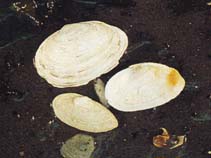Mya arenaria Linnaeus, 1758
Softshell clam| Native range | All suitable habitat | Point map | Year 2050 |

|
| This map was computer-generated and has not yet been reviewed. |
| Mya arenaria AquaMaps Data sources: GBIF OBIS |
Classification / Names Tên thường gặp | Các synonym ( Các tên trùng) | CoL | ITIS | WoRMS
Bivalvia | Myida | Myidae
Environment: milieu / climate zone / Mức độ sâu / distribution range Sinh thái học
; Thuộc về nước lợ; Mức độ sâu 0 - 192 m (Tài liệu tham khảo 78574), usually 0 - 25 m (Tài liệu tham khảo 75831). Temperate, preferred 9°C (Tài liệu tham khảo 107945); 77°N - 33°N, 180°W - 180°E (Tài liệu tham khảo 113928)
Distribution Các nước | Các khu vực của FAO | Các hệ sinh thái | Những lần xuất hiện | Những chỉ dẫn
Northwest Atlantic from Nova Scotia to Virginia, North Sea and European waters including the Black, Baltic, Wadden, White and Mediterranean seas, and northeast Pacific from San Francisco to Alaska.
Length at first maturity / Bộ gần gũi / Weight / Age
Chín muồi sinh dục: Lm ? range ? - ? cm Max length : 10.0 cm TL con đực/không giới tính; (Tài liệu tham khảo 7726); Tuổi cực đại được báo cáo: 8 các năm (Tài liệu tham khảo 2823)
Life cycle and mating behavior Chín muồi sinh dục | Sự tái sinh sản | Đẻ trứng | Eggs | Sự sinh sản | Larvae
Main reference
Các tài liệu tham khảo | Người điều phối | Người cộng tác
Harvey-Clark, C. 1997 Eastern tidepool and reef: north-central Atlantic marinelife guide. Hancock House Publishers, 64pp. (Tài liệu tham khảo 7726)
IUCN Red List Status
(Tài liệu tham khảo 130435: Version 2025-1)
CITES status (Tài liệu tham khảo 108899)
CMS (Tài liệu tham khảo 116361)
Threat to humans
Human uses
Các nghề cá: Tính thương mại
FAO - Nuôi trồng thủy sản: production; Các nghề cá: landings | FishSource | Biển chung quanh ta
Các công cụ
Thêm thông tin
Max. ages / sizes
Length-weight rel.
Length-length rel.
Length-frequencies
Mass conversion
Sự phong phú
Các nguồn internet
BHL | BOLD Systems | CISTI | DiscoverLife | FAO(Các nghề cá: ; publication : search) | Fishipedia | GenBank (genome, nucleotide) | GloBI | Gomexsi | Google Books | Google Scholar | Google | PubMed | Cây Đời sống | Wikipedia (Go, tìm) | Tạp chí Zoological Record



